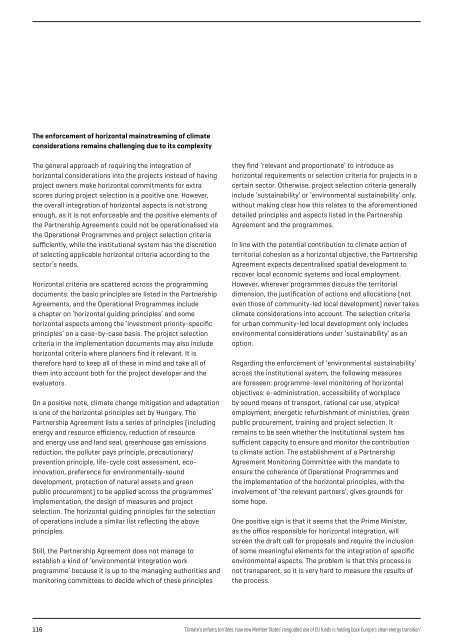ENFANTS TERRIBLES
enfants-terribles
enfants-terribles
You also want an ePaper? Increase the reach of your titles
YUMPU automatically turns print PDFs into web optimized ePapers that Google loves.
The enforcement of horizontal mainstreaming of climate<br />
considerations remains challenging due to its complexity<br />
The general approach of requiring the integration of<br />
horizontal considerations into the projects instead of having<br />
project owners make horizontal commitments for extra<br />
scores during project selection is a positive one. However,<br />
the overall integration of horizontal aspects is not strong<br />
enough, as it is not enforceable and the positive elements of<br />
the Partnership Agreements could not be operationalised via<br />
the Operational Programmes and project selection criteria<br />
sufficiently, while the institutional system has the discretion<br />
of selecting applicable horizontal criteria according to the<br />
sector’s needs.<br />
Horizontal criteria are scattered across the programming<br />
documents: the basic principles are listed in the Partnership<br />
Agreements, and the Operational Programmes include<br />
a chapter on ‘horizontal guiding principles’ and some<br />
horizontal aspects among the ’investment priority-specific<br />
principles’ on a case-by-case basis. The project selection<br />
criteria in the implementation documents may also include<br />
horizontal criteria where planners find it relevant. It is<br />
therefore hard to keep all of these in mind and take all of<br />
them into account both for the project developer and the<br />
evaluators.<br />
On a positive note, climate change mitigation and adaptation<br />
is one of the horizontal principles set by Hungary. The<br />
Partnership Agreement lists a series of principles (including<br />
energy and resource efficiency, reduction of resource<br />
and energy use and land seal, greenhouse gas emissions<br />
reduction, the polluter pays principle, precautionary/<br />
prevention principle, life-cycle cost assessment, ecoinnovation,<br />
preference for environmentally-sound<br />
development, protection of natural assets and green<br />
public procurement) to be applied across the programmes’<br />
implementation, the design of measures and project<br />
selection. The horizontal guiding principles for the selection<br />
of operations include a similar list reflecting the above<br />
principles.<br />
Still, the Partnership Agreement does not manage to<br />
establish a kind of ‘environmental integration work<br />
programme’ because it is up to the managing authorities and<br />
monitoring committees to decide which of these principles<br />
they find ‘relevant and proportionate’ to introduce as<br />
horizontal requirements or selection criteria for projects in a<br />
certain sector. Otherwise, project selection criteria generally<br />
include ‘sustainability’ or ‘environmental sustainability’ only,<br />
without making clear how this relates to the aforementioned<br />
detailed principles and aspects listed in the Partnership<br />
Agreement and the programmes.<br />
In line with the potential contribution to climate action of<br />
territorial cohesion as a horizontal objective, the Partnership<br />
Agreement expects decentralised spatial development to<br />
recover local economic systems and local employment.<br />
However, wherever programmes discuss the territorial<br />
dimension, the justification of actions and allocations (not<br />
even those of community-led local development) never takes<br />
climate considerations into account. The selection criteria<br />
for urban community-led local development only includes<br />
environmental considerations under ‘sustainability’ as an<br />
option.<br />
Regarding the enforcement of ‘environmental sustainability’<br />
across the institutional system, the following measures<br />
are foreseen: programme-level monitoring of horizontal<br />
objectives: e-administration, accessibility of workplace<br />
by sound means of transport, rational car use, atypical<br />
employment, energetic refurbishment of ministries, green<br />
public procurement, training and project selection. It<br />
remains to be seen whether the institutional system has<br />
sufficient capacity to ensure and monitor the contribution<br />
to climate action. The establishment of a Partnership<br />
Agreement Monitoring Committee with the mandate to<br />
ensure the coherence of Operational Programmes and<br />
the implementation of the horizontal principles, with the<br />
involvement of ‘the relevant partners’, gives grounds for<br />
some hope.<br />
One positive sign is that it seems that the Prime Minister,<br />
as the office responsible for horizontal integration, will<br />
screen the draft call for proposals and require the inclusion<br />
of some meaningful elements for the integration of specific<br />
environmental aspects. The problem is that this process is<br />
not transparent, so it is very hard to measure the results of<br />
the process.<br />
116<br />
‘Climate’s enfants terribles: how new Member States’ misguided use of EU funds is holding back Europe’s clean energy transition’


